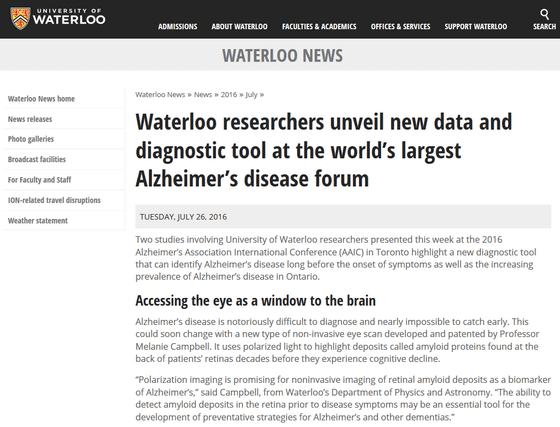New technology that allows you to know about the symptoms of Alzheimer's disease from the 'eye' has come up, making it possible to inspect cheaper and earlier than before

ByHeather Schleiffer
So far, it was very difficult to grasp the signs of Alzheimer's disease at an early stage, but researchers at the University of Waterloo in Canada examined the "eyes" and found that they could grasp symptoms very early Announced.
Waterloo researchers unveil new data and diagnostic tool at the world's largest Alzheimer's disease forum | Waterloo News
https://uwaterloo.ca/news/news/waterloo-researchers-unveil-new-data-and-diagnostic-tool

Why Eye Exams Are the Future of Alzheimer's Screening | Motherboard
http://motherboard.vice.com/read/-why-eye-exams-are-the-future-of-alzheimers-screening-retina
This research result was held in TorontoThe 28th International Alzheimer's Disease Conference (AAIC), And what Professor Melanie Campbell of Waterloo University announced. The research was conducted with the cooperation of Waterloo University, British Columbia University, research firm Vivocore and InterVivo Solutions, University of Rochester, Massachusetts General Hospital.
Professor Campbell

As a characteristic of Alzheimer's disease, amyloid plaques (senile plaques) can be formed in the patient's brain, but it is thought that a protein called "amyloid β" is involved in the formation of this amyloid plaque, and it is considered that Alzheimer's disease Amyloid β accumulates in the brain several decades before onset. As this amyloid β is a protein that is brought to the eye via the spinal fluid of the brain, amyloid β accumulates in the retina as well as in the brain.
Professor Campbell thought that something similar to what is happening in the brain occurs with the eyes and that the source of amyloid plaques is created (amyloid deposits). Other researchers have thought that dye is necessary to make amyloid visible, but Professor Campbell and others thought that amyloid can be visualized by optical and computer processing. Therefore, we made equipment that can scan the polarized light that makes amyloid emerge, and actually carried out demonstration experiments on the retina of humans and dogs.
As a result, we found that new technology can easily detect not only amyloid deposits but also size comparisons that could not be done with other imaging technologies. For diagnosis of Alzheimer's diseasePositron emission tomography (PET)Although effective, the method used by Professor Campbell et al. Is not as expensive as PET, it can be widely used and it can be found at an early stage. However, "detection of amyloid deposits" does not immediately lead to "Alzheimer's disease", but Professor Campbell says, "This new technology helps researchers in Alzheimer's disease develop more effective treatment methods It will be ".
Professor Campbell said "This method will help Alzheimer's researchers develop more effective treatment methods."
Also at AAIC, Professor Colin Maxwell of Waterloo University studied Alzheimer's patients 18% among patients over 65 in Ontario between 2004 and 2005 and between 2012 and 2013, We announced that it increased.
Related Posts:
in Science, Posted by logc_nt







